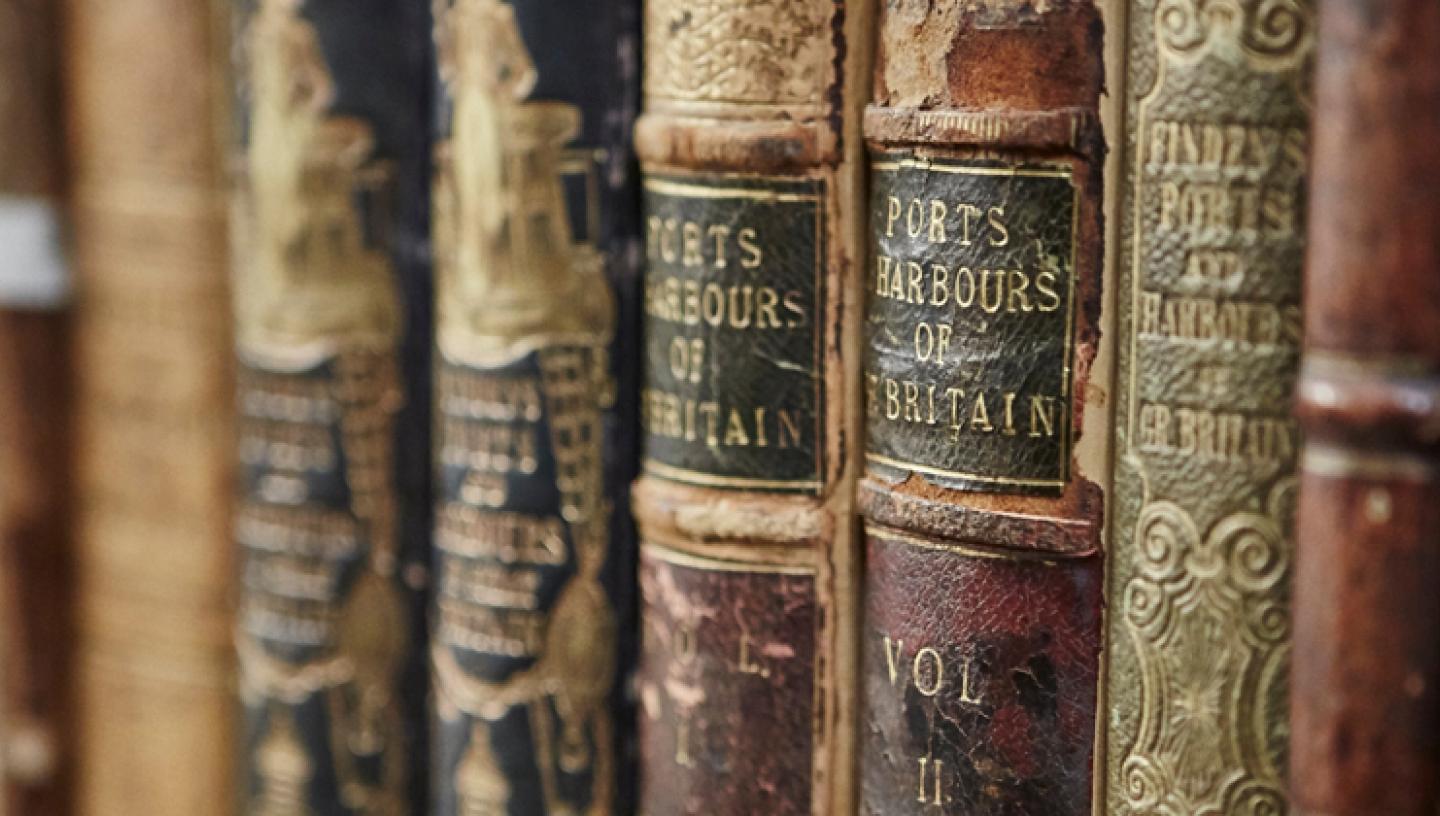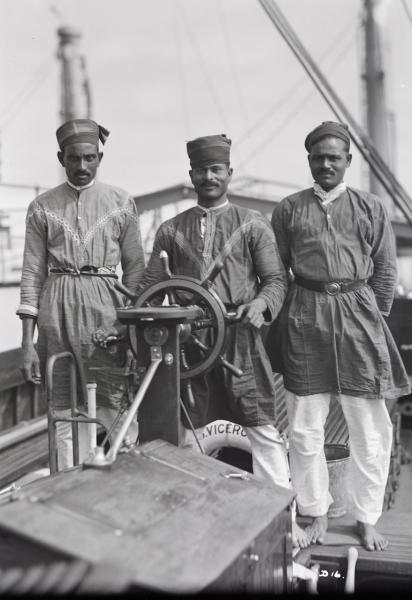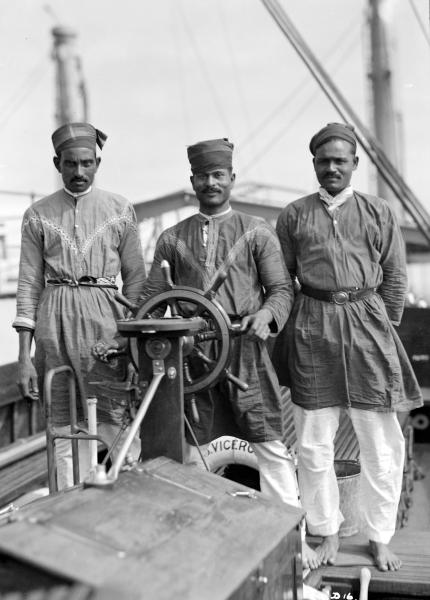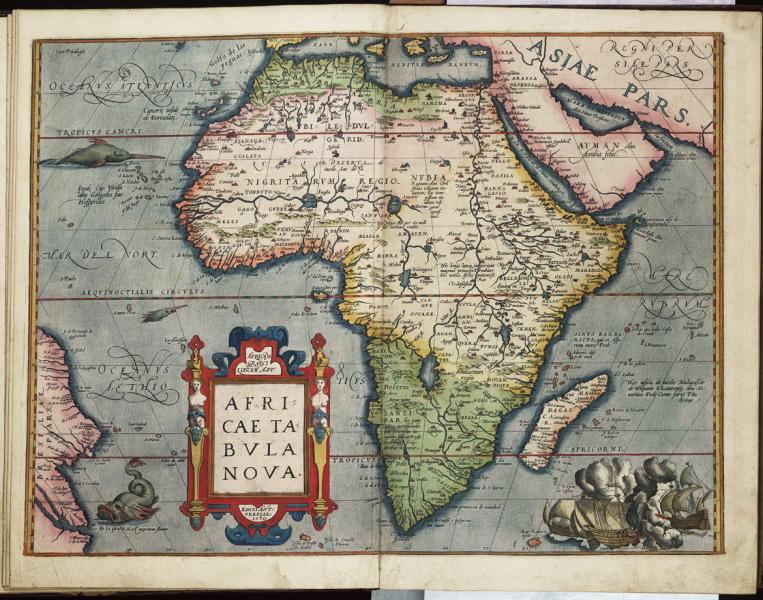
Black people began to appear aboard English vessels during the Tudor period, if not before. They worked as sailors, divers, soldiers, personal attendants and musicians. This included free individuals as well as those who had been enslaved.
Black sailors became very common aboard British ships during the 18th century, and could be found among the crews of naval vessels, merchantmen, slavers and pirate ships during this period. They continued to serve in large numbers throughout the 19th and 20th centuries.
Asian sailors also have a long history of serving aboard British ships. The most numerous were those known as ‘lascars’, a sweeping term used by Europeans to refer to seafarers from the Indian Ocean region. Lascars began to appear aboard the East India Company’s vessels during the 17th century. Hundreds of lascars were arriving in British ports each year by 1850, some of whom settled permanently.
Archival material relating to black and Asian sailors is listed in our online archive catalogue and can be viewed at the Caird Library. Family historians and other researchers wishing to trace individual sailors may wish to consult the following records:
Records of the Dreadnought Seaman’s Hospital:
The Seaman’s Hospital Society was founded in the early 19th century to care for sailors. The society ran hospital ships before opening the Dreadnought Seamen’s Hospital at Greenwich in 1870.
Please refer to this blog article for more information about the Dreadnought Seaman's Hospital.
The National Maritime Museum holds patient and staff records produced by the society during the period 1826–1972 (Ref.No.: DSH/). The Hospital’s admission registers list thousands of patients, providing information such as age, place of birth, rank, medical condition and number of years spent at sea. This includes numerous sailors listed as being born in parts of Africa, Asia and the Caribbean.
The registers are now available online on Ancestry.co.uk - search the card catalogue for 'Dreadnought'.
Please note that access to registers covering the past 100 years is restricted due to data protection laws.
1915 Crew Lists:
The 1915 British Merchant Navy crew lists (RSS/CL/1915/) are a valuable resource for family historians searching for people who may have served aboard a British merchant ship during this year.
These lists, which can be searched online, contain the names of over 750,000 sailors from around the world. This includes men from places that are now part of Egypt, Somalia, Tanzania, Iran, Yemen, Pakistan, India, Bangladesh and China.
Crew Lists of the British Merchant Navy - 1915
Crew lists for many other years are also available at the Caird Library but they have not been digitized. Research guide C1: The Merchant Navy
Cooks’ Certificates:
The Museum recently discovered over 2000 certificates issued by the Registrar General of Shipping and Seamen between 1913 and 1972 (RSS/CC/).
The vast majority of these documents were issued in Calcutta and relate to South Asian men who qualified as cooks. They typically include the name, date of birth, country of origin, physical characteristics and a portrait photograph of the sailor in question. The Museum is currently cataloguing this import collection of documents, which will be available to researchers in the future.
Other Research Guides:
Also recommended are our other research guides on finding ancestors using maritime records, including:
- A3: tracing family history from maritime records
- B1: The Royal Navy: Tracing people
- C1: The Merchant Navy: Tracing people: Crew lists, agreements and official logs
Logbook and Journal Collection:
The National Maritime Museum’s collection of logbooks (LOG/) and journals (JOD/), which can also be viewed at the Caird Library, is a rich source of information on lascars.
Crew lists, usually found at the front or back of logbooks, often list lascars (e.g. LOG/C/5, LOG/C/58, LOG/C/81). Some crew lists only give names but others provide information such as region of origin, dates of service, wages received and the manner of leaving the ship (typically ‘discharged’, ‘run’/‘deserted’ or ‘died’).
The logbooks of vessels sailing to/from Indian Ocean ports are the most likely places to find references to lascars, but such men are known to have sailed around the globe aboard British ships.
Lascars are also mentioned in personal diaries kept by passengers at sea. Again, the most likely place to find such references is in the writings of men and women travelling to/from ports in the Indian Ocean (e.g. JOD/5, JOD/139, JOD/263). Passengers sometimes included detailed descriptions or even sketches of lascars in their diaries (e.g. IGR/27).
Images of Black and Asian seafarers:
These appear throughout the Museum’s collection of photograph albums, with photographs of black sailors serving in the Royal Navy particularly common (e.g. ALB123, ALB264, and ALB975).
The collection also includes images of Asian sailors working aboard merchantmen, passenger liners, oil tankers and other vessels (e.g. ALB485, ALB1080, and ALB1392).
Material associated with the Peninsular and Oriental Steam Navigation Company (P&O) (e.g. ALB488, ALB502, ALB1249) and James Nourse Ltd (NOU/) is particularly rich in this respect.
Sailors are not always identified by name in photographs; researchers looking for individuals are advised to search using the name of the ship in which a person served.
All albums (items labelled ‘ALB/…’) are stored at our outstation in Woolwich, rather than at our main site in Greenwich, and can be viewed by making an appointment to visit.
The National Maritime Museum’s wider collection, which can be searched using our Collections Online catalogue, also includes material relating to black and Asian seafarers.
Visit Collections Online
Sir Walter Raleigh’s book, The Discovery of Guiana (1596), features an image of an enslaved African who sailed with him and was killed in the Orinoco River. This is one of the earliest representations of a black person in the collection (PAG7517).
The National Maritime Museum’s art collection also includes numerous depictions of black sailors and other black people who were involved in the maritime world during the 18th, 19th and 20th centuries (e.g. PAF3120, PAI4305, ZBA2671, and BHC1159).
Further reading:
- Balachandran, Gopalan, Globalizing Labour? Indian Seafarers and World Shipping, c. 1870–1945 (New Delhi, 2012)
- Bolster, W. Jeffrey, Black Jacks: African American Seamen in the Age of Sail (Cambridge, MA, 1997)
- Costello, Ray, Black Salt: Seafarers of African Descent on British Ships (Liverpool, 2012)
- Grannum, Guy, Tracing your Caribbean Ancestors: A National Archives Guide (3rd edn, London, 2012)
- Jaffer, Aaron, Lascars and Indian Ocean Seafaring: Shipboard Life, Unrest and Mutiny (Woodbridge, 2015)
- Russell, Lynette, Roving Mariners: Australian Aboriginal Whalers and Sealers in the South Oceans, 1790–1870 (Albany, 2012)
- Spence, Craig, ‘Seeing some black in the Union Jack’ History Today, 52:10 (2002)
- Tilford, John, My Ancestor Settled in the British West Indies (London, 2011)
- Visram, Rozina, Ayahs, Lascars and Princes: Indians in Britain, 1700–1947 (London, 1986)


